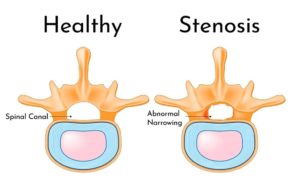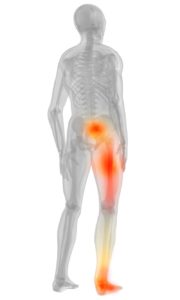What is Spinal Stenosis?
If you heard the words spinal stenosis for the first time from your doctor, or maybe from a Google search about lower back pain, or neck pain, you might be wondering just what does spinal stenosis mean?
Spinal stenosis happens when one of the openings within your spine, called foramina, narrow and reduce the space for your nerves. There are a couple locations this can happen at. One is the narrow canal the spinal nerves run through in the center of your spine, and the other is the place where your nerves exit the spine.
The impact of the stenosis will depend on the location, and just how much foraminal narrowing takes place. You could experience pain, tingling and numbness if your spinal cord is compressed.
Common Causes of Stenosis in the Spine
The most common cases of stenosis are from aging known as degenerative disc disease. Since your spinal disc becomes dehydrated over time and your foramina narrow as a result.
Osteoarthritis is when the cartilage breaks down so your bones rub against each other. Bone spurs can occur and they will contribute to your foramina narrowing.
What are the symptoms of spinal stenosis?
Spinal stenosis affects your neck or lower back depending on the location of the degeneration. There is a stiffness in your neck or back, associated with a numbness and pain. As the symptoms progress it can lead to sciatica, or pains down your leg and lower back. You may have a hard time standing or walking because of painful leg weakness.
Lumbar Spinal Stenosis
The lumbar spine is a segment of your spine located between your pelvis bone and your ribs. There are five vertebrae that make up your lumbar spine. Lumbar spinal stenosis is when the narrowing of the foramina in your spine happens in this region. The area that spinal stenosis happens effects what kind of symptoms you exhibit and what kind of treatment plan your doctor is going to prepare for you.
Lumbar Spine Stenosis Symptoms
Lumbar spine stenosis is when this area is affected by spinal stenosis, or the narrowing of bone canals. When lumbar stenosis takes place it is more likely to travel through the legs and may cause cramps in your calves, pain in the thighs and legs that is similar to sciatica.
The pain can get worse when bending forward, sitting or laying down, and in some extreme cases can cause impairment of the legs and/or bladder function.
Cervical Stenosis
Cervical spinal stenosis happens when stenosis effects the neck portion of your spine. Because the compression of nerves in your neck are going to effect surrounding regions, you’re going to experience balance or coordination problems. The pain will also be around the neck, shoulders, arms, and hands. The spinal cord compression in your neck can also cause neurological conditions called myelopathy.
Cervical Spondylotic Myelopathy
When cervical stenosis causes myelopathy it’s called cervical spondylotic myelopathy. Spondylosis means the degeneration of the spine, and stenosis is the narrowing of the canal that compresses the nerves. Usually this is caused by age degeneration, or due to arthritis. It can also be caused by bone spurs, herniated discs, and swollen ligaments. The process is slow, but if an injury occurs this can accelerate the degeneration.

What is the best treatment for spinal stenosis?
When you experience either lumbar spinal stenosis or cervical stenosis, you will want to look at what treatment options work for you. There are medical treatments and surgical treatments available based on the severity of your case. There are short term pain relief medications, exercise, or surgery in more severe cases. Let’s go into more detail about your options.
Medical Treatments of Spinal Stenosis
The first thing you can try is taking non-steroidal anti-inflammatory drugs (or NSAIDs) as pain relief. If you need immediate short term relief you can also try receiving cortisone injections into your spinal column. Exercise and physical therapy to strengthen your back and abdominal muscles can help as well. If these treatments aren’t working for you and you need a more permanent solution to your neck or back pain surgery is a good option.
Spinal Stenosis Surgery Treatments for Serious Cases
There are a few types of surgeries for spinal stenosis that can decompress the spinal canal and permanently relieve your pain.
Laminectomy removes a portion of the vertebra, called the lamina, to stop the bone from pinching your nerves.
Foraminotomy is an operation on the foramen, where your nerves exit the spine, and widens this space to stop the pressure on the nerves.
Spinal fusion joins vertebra together with screws and/or bone grafts to create spinal stability. This may be done in conjunction with a laminectomy surgery in order to allow decompression of the nerves and prevent future issues through the fusion.
The surgery type will depend on how your spinal stenosis has progressed, and where in your spine the compression is happening. Your doctor or neurosurgeon will go over the process with you, and what to expect before and after the surgery.
What activities should be avoided with spinal stenosis?
Activities that compress your spine should generally be avoided. Leaning back while standing for instance can compress an already narrow spinal foramina. You’ll want to do the opposite of this such as knee hugs to open up compressed areas of the spine. If you’re waiting to schedule an MRI or consult with a doctor about surgical possibilities, definitely avoid compressing your spine further and reach out to a medical professional today.


